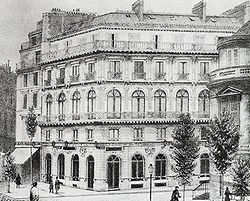.gif)
Maison dorée (Paris)
Encyclopedia

Boulevard des Italiens
The boulevard des Italiens is one of the four 'grands boulevards' in Paris, a chain running east west and also including boulevard de la Madeleine, Boulevard des Capucines and boulevard Montmartre...
, Paris.
Beginnings
The Maison Dorée story begins with the Stainville-Choiseul hotel where Madame TallienThérésa Tallien
Thérésa Cabarrus, Madame Tallien , was a French social figure during the Revolution. Later she became Princess of Chimay.-Early life:...
lived. She was known as "Our Lady of Thermidor," the most famous of the Marvelous, a group of eccentric women at the time of the French Revolution
French Revolution
The French Revolution , sometimes distinguished as the 'Great French Revolution' , was a period of radical social and political upheaval in France and Europe. The absolute monarchy that had ruled France for centuries collapsed in three years...
.
The story continues with the Café Hardy, famous during Napoleon's Empire, which was established at the junction of the Boulevard de Gand (now Boulevard des Italiens
Boulevard des Italiens
The boulevard des Italiens is one of the four 'grands boulevards' in Paris, a chain running east west and also including boulevard de la Madeleine, Boulevard des Capucines and boulevard Montmartre...
) and the rue Cerutti (now rue Laffitte
Rue Laffitte
Rue Laffitte is a street in Paris' IXe arrondissement.This street was created in 1771 between the Boulevard des Italiens and the Rue de Provence. Its original name was Rue d'Artois, in honour of the Comte d'Artois, brother of the king Louis XVI, later king of France with the name of Charles X...
). At the Café Hardy, according to one source, "you could eat the best chops in Paris, andouillettes stuffed with truffles ... that would give appetite to a dying guy. "
It was the most expensive restaurant in Paris, heralded by contemporary newspapers: "You have to be rich to dine at Hardy and bold to dine at Riche" ("hardy" means "bold" in French; Café Riche was on the other side of the rue Laffitte).
The property was sold at a very high price in 1836 to the Hamel brothers, who already owned the café de Chartres (the Grand Véfour) at the Palais-Royal.
Maison Dorée
Although the date 1839 appears on the facade of the building, exactly when it was built is unknown. Initially, the restaurant was called "Restaurant of the Cité," but because of its luxurious design, with paintings and mirrors, and gilding on the balconies and balustrades, the public named it "Maison Dorée."The restaurant was divided into two sections: one section accessible from the boulevard, for ordinary people, and another section, accessible via rue Laffitte, for wealthy customers. This section had luxurious and discrete "Cabinets," or private rooms. The most desired was Cabinet 6, which was reserved for nobility as well as for very wealthy people. The restaurant's magnificent wine cellar, with 80,000 bottles of wine, attracted the rich revelers and party-goers of Paris.
People who dined there included the future King Edward VII, Lord Sémour, and the Baron de Saint Cricq. Novelists of the time could be found there, most famously Balzac, who had a character from his novels, Lucien de Rubempré, eat there. In the novel In Search of Lost Time
In Search of Lost Time
In Search of Lost Time or Remembrance of Things Past is a novel in seven volumes by Marcel Proust. His most prominent work, it is popularly known for its considerable length and the notion of involuntary memory, the most famous example being the "episode of the madeleine." The novel is widely...
, Marcel Proust's character Swann enters the restaurant looking for Odette. When he doesn't find her there, he falls deeply in love.
It has been claimed that the dish tournedos Rossini
Tournedos Rossini
Tournedos Rossini is a French steak dish, purportedly created for the composer Gioachino Rossini by Auguste Escoffier, although the identity of the creator of the dish remains a matter of dispute. The dish comprises a tournedos of beef, pan-fried in butter, served on a crouton, and topped with a...
was created by the chef of the Maison Dorée, Casimir Moisson, who created the recipe for the composer Gioachino Rossini, a regular customer.
In the building above the restaurants, several newspapers opened editorial offices. In 1853, Alexandre Dumas moved the offices of his newspaper "Le Mousquetaire" to the building.
The same building was the site of the 8th and last Impressionist painting exhibition, which took place on May 15, 1886. Impressionism, which had started at 35 boulevard des Capucines in 1874, ended on boulevard des Italiens 12 years later.
The end

Between 1974 to 1976, BNP Paribas
BNP Paribas
BNP Paribas S.A. is a global banking group, headquartered in Paris, with its second global headquarters in London. In October 2010 BNP Paribas was ranked by Bloomberg and Forbes as the largest bank and largest company in the world by assets with over $3.1 trillion. It was formed through the merger...
moved its corporate headquarters into the building. The French Minister of Culture at the time, Maurice Druon
Maurice Druon
Maurice Druon was a French novelist and a member of the Académie française.Born in Paris, France, Druon was the nephew of the writer Joseph Kessel, with whom he translated the Chant des Partisans, a French Resistance anthem of World War II, with music and words originally by Anna Marly.In 1948...
, facing pressure from a neighborhood preservation committee, encouraged the company to maintain the building's historic facade. BNP's architect, "in one day of rage against the old timers," created a new project in which he proposed to integrate an entirely new interior into the historic facade. This marked the first transformation of what became a highly controversial movement called facadism
Facadism
Façadism is the practice of demolishing a building but leaving its facade intact for the purposes of building new structures in it or around it....
.

